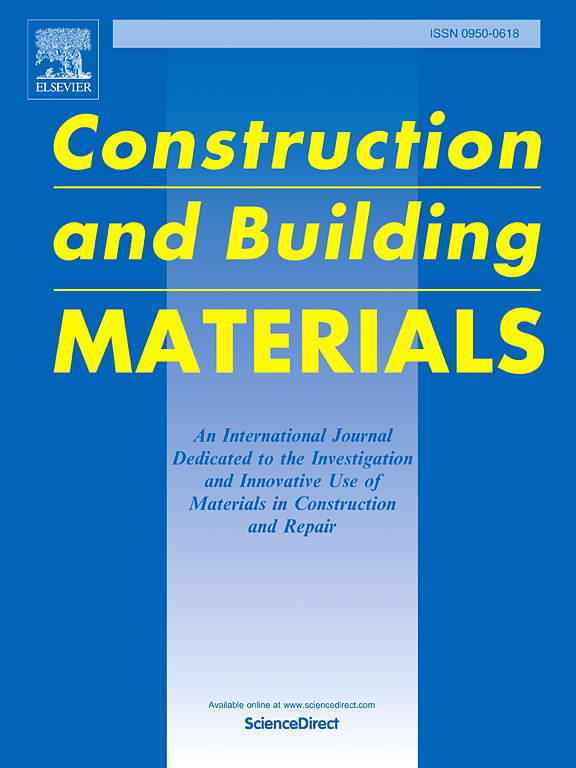Feasibility of coal bottom ash as fine aggregate in strain-hardening cementitious composites: A study on strength, durability, and sustainability
IF 8
1区 工程技术
Q1 CONSTRUCTION & BUILDING TECHNOLOGY
引用次数: 0
Abstract
The search for cost-effective and sustainable materials for strain-hardening cementitious composites (SHCC) has led researchers to explore alternatives to silica sand, a critical yet costly and environmentally unfavorable material. Although river sand seems like a cheaper and viable alternative, its extraction is linked to severe environmental degradation. This study aims to investigate the potential of coal bottom ash (CBA) as a replacement for silica sand in SHCC, targeting to meet the minimum requirements for structural applications. The novelty of this research lies in its comprehensive exploration of CBA as a partial to full replacement for silica sand (at 0 %, 25 %, 50 %, 75 %, and 100 %), extending beyond the replacement limit investigated in previous studies on SHCC, and provides an extensive evaluation of the composite’s fresh, mechanical, durability, and microstructural properties. Additionally, it includes a thorough assessment of the leaching potential, CO₂ emissions, energy consumption, and cost implications of the CBA-SHCC, which have not been fully explored in earlier CBA-SHCC research. The findings indicate that the reduction in mechanical strength was minimal (0.5 %-10 %) across all CBA replacement levels. Notably, all mixes demonstrated typical strain-hardening behavior, sustaining higher flexural loads beyond the first crack, with increased deflection capacity observed at higher CBA contents, peaking at 50 % replacement. Durability metrics, including water absorption and HCl acid attack resistance, exhibited a downward trend with higher CBA content but remained within acceptable limits up to 75 % replacement. Toxicity characteristic leaching procedure results confirmed the non-leachability of toxic elements in both the CBA and CBA-SHCC mixes. Economically and environmentally, CBA proved advantageous, resulting in 1.5–5 % lower CO2 emissions, 0.4–1.5 % lower energy consumption, and 18–84 % cost savings at 25–100 % CBA replacement. Additionally, a multicriteria analysis using the Technique for Order Preference by Similarity to Ideal Solution (TOPSIS) was employed, which identified 25 % as the optimal CBA content that balances fresh properties, mechanical strength, durability, environmental sustainability, and cost efficiency. The study is significant because it demonstrated that CBA can be used as a sustainable and cost-effective alternative to silica sand in SHCC, with lower environmental impact while maintaining structural integrity.
粉煤灰作为细骨料在应变硬化胶凝复合材料中的可行性:强度、耐久性和可持续性研究
为了寻找具有成本效益和可持续发展的应变硬化胶凝复合材料(SHCC),研究人员探索了硅砂的替代品,硅砂是一种关键但昂贵且对环境不利的材料。虽然河砂似乎是一种更便宜和可行的替代品,但它的开采与严重的环境退化有关。本研究旨在探讨煤底灰(CBA)作为SHCC中硅砂替代品的潜力,以满足结构应用的最低要求。这项研究的新颖之处在于,它全面探索了CBA作为硅砂的部分到完全替代品(0 %,25 %,50 %,75 %和100 %),超出了先前研究中对SHCC的替代限制,并对复合材料的新鲜、机械、耐久性和微观结构性能进行了广泛的评估。此外,它还包括对CBA-SHCC的浸出潜力、CO₂排放、能源消耗和成本影响的全面评估,这些在早期的CBA-SHCC研究中没有得到充分的探讨。研究结果表明,在所有CBA替换水平中,机械强度的降低是最小的(0.5 %-10 %)。值得注意的是,所有混合材料都表现出典型的应变硬化行为,在第一次裂缝之后承受更高的弯曲载荷,在更高的CBA含量下观察到挠曲能力增加,在50% %替代时达到峰值。耐久性指标,包括吸水率和抗HCl酸侵蚀性能,随着CBA含量的增加呈现下降趋势,但仍在可接受的范围内,最高可达75% %替代。毒性特征浸出程序结果证实了CBA和CBA- shcc混合物中有毒元素的不可浸出性。在经济和环境方面,CBA被证明是有利的,导致二氧化碳排放量降低1.5-5 %,能源消耗降低0.4-1.5 %,更换25-100 %的CBA可节省18-84 %的成本。此外,采用TOPSIS (Order Preference Technique for Order Preference by Similarity to Ideal Solution)进行多标准分析,确定了25 %的CBA含量是平衡新鲜性能、机械强度、耐久性、环境可持续性和成本效率的最佳CBA含量。该研究具有重要意义,因为它证明了CBA可以作为SHCC中硅砂的可持续且具有成本效益的替代品,在保持结构完整性的同时降低了环境影响。
本文章由计算机程序翻译,如有差异,请以英文原文为准。
求助全文
约1分钟内获得全文
求助全文
来源期刊

Construction and Building Materials
工程技术-材料科学:综合
CiteScore
13.80
自引率
21.60%
发文量
3632
审稿时长
82 days
期刊介绍:
Construction and Building Materials offers an international platform for sharing innovative and original research and development in the realm of construction and building materials, along with their practical applications in new projects and repair practices. The journal publishes a diverse array of pioneering research and application papers, detailing laboratory investigations and, to a limited extent, numerical analyses or reports on full-scale projects. Multi-part papers are discouraged.
Additionally, Construction and Building Materials features comprehensive case studies and insightful review articles that contribute to new insights in the field. Our focus is on papers related to construction materials, excluding those on structural engineering, geotechnics, and unbound highway layers. Covered materials and technologies encompass cement, concrete reinforcement, bricks and mortars, additives, corrosion technology, ceramics, timber, steel, polymers, glass fibers, recycled materials, bamboo, rammed earth, non-conventional building materials, bituminous materials, and applications in railway materials.
 求助内容:
求助内容: 应助结果提醒方式:
应助结果提醒方式:


